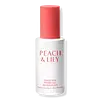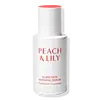What's inside
What's inside
 Key Ingredients
Key Ingredients

 Benefits
Benefits

 Concerns
Concerns

No concerns
 Ingredients Side-by-side
Ingredients Side-by-side

Water
Skin ConditioningGlycerin
HumectantPropanediol
Solvent1,2-Hexanediol
Skin ConditioningCalendula Officinalis Flower Water
MaskingSodium Hyaluronate
HumectantHydrolyzed Hyaluronic Acid
HumectantActinidia Chinensis Fruit Extract
EmollientPrunus Persica Fruit Extract
AbrasiveAnthemis Nobilis Flower Water
MaskingBambusa Textilis Stem Extract
Skin ConditioningArctium Lappa Root Extract
Skin ConditioningMorus Alba Leaf Extract
Skin ConditioningMorus Alba Fruit Extract
AntioxidantLeuconostoc/Radish Root Ferment Filtrate
AntimicrobialApium Graveolens Extract
Skin ConditioningLactobacillus Ferment
Skin ConditioningBeta-Glucan
Skin ConditioningFructooligosaccharides
HumectantGlycyrrhiza Glabra Root Extract
BleachingSodium Acetylated Hyaluronate
HumectantMyrciaria Dubia Fruit Extract
Skin ConditioningGanoderma Lucidum Extract
Skin ProtectingButylene Glycol
HumectantMelia Azadirachta Leaf Extract
Skin ConditioningMelia Azadirachta Flower Extract
Skin ConditioningAdenosine
Skin ConditioningTrisodium Ethylenediamine Disuccinate
Carbomer
Emulsion StabilisingEthylhexylglycerin
Skin ConditioningMorus Alba Twig Extract
Skin ConditioningMorus Alba Bark Extract
Skin ConditioningTromethamine
BufferingXylose
HumectantTocopherol
AntioxidantWater, Glycerin, Propanediol, 1,2-Hexanediol, Calendula Officinalis Flower Water, Sodium Hyaluronate, Hydrolyzed Hyaluronic Acid, Actinidia Chinensis Fruit Extract, Prunus Persica Fruit Extract, Anthemis Nobilis Flower Water, Bambusa Textilis Stem Extract, Arctium Lappa Root Extract, Morus Alba Leaf Extract, Morus Alba Fruit Extract, Leuconostoc/Radish Root Ferment Filtrate, Apium Graveolens Extract, Lactobacillus Ferment, Beta-Glucan, Fructooligosaccharides, Glycyrrhiza Glabra Root Extract, Sodium Acetylated Hyaluronate, Myrciaria Dubia Fruit Extract, Ganoderma Lucidum Extract, Butylene Glycol, Melia Azadirachta Leaf Extract, Melia Azadirachta Flower Extract, Adenosine, Trisodium Ethylenediamine Disuccinate, Carbomer, Ethylhexylglycerin, Morus Alba Twig Extract, Morus Alba Bark Extract, Tromethamine, Xylose, Tocopherol
Water
Skin ConditioningPropanediol
SolventButylene Glycol
HumectantNiacinamide
Smoothing1,2-Hexanediol
Skin ConditioningPrunus Persica Fruit Extract
AbrasiveDioscorea Japonica Root Extract
Skin ConditioningSodium Hyaluronate
HumectantAdenosine
Skin ConditioningHydrolyzed Sodium Hyaluronate
Skin ConditioningMadecassoside
AntioxidantHydrolyzed Hyaluronic Acid
HumectantSodium Acetylated Hyaluronate
HumectantAcetyl Octapeptide-3
HumectantEthylhexylglycerin
Skin ConditioningHydrolyzed Corn Starch
HumectantSodium Carbomer
Emulsion StabilisingBeta-Glucan
Skin ConditioningSaccharide Isomerate
HumectantPhytic Acid
Sucrose
HumectantAsiaticoside
AntioxidantCaprylyl Glycol
EmollientWater, Propanediol, Butylene Glycol, Niacinamide, 1,2-Hexanediol, Prunus Persica Fruit Extract, Dioscorea Japonica Root Extract, Sodium Hyaluronate, Adenosine, Hydrolyzed Sodium Hyaluronate, Madecassoside, Hydrolyzed Hyaluronic Acid, Sodium Acetylated Hyaluronate, Acetyl Octapeptide-3, Ethylhexylglycerin, Hydrolyzed Corn Starch, Sodium Carbomer, Beta-Glucan, Saccharide Isomerate, Phytic Acid, Sucrose, Asiaticoside, Caprylyl Glycol
 Reviews
Reviews

Ingredients Explained
These ingredients are found in both products.
Ingredients higher up in an ingredient list are typically present in a larger amount.
1,2-Hexanediol is a synthetic liquid and another multi-functional powerhouse.
It is a:
- Humectant, drawing moisture into the skin
- Emollient, helping to soften skin
- Solvent, dispersing and stabilizing formulas
- Preservative booster, enhancing the antimicrobial activity of other preservatives
Adenosine is in every living organism. It is one of four components in nucleic acids that helps store our DNA.
Adenosine has many benefits when used. These benefits include hydrating the skin, smoothing skin, and reducing wrinkles. Once applied, adenosine increases collagen production. It also helps with improving firmness and tissue repair.
Studies have found adenosine may also help with wound healing.
In skincare products, Adenosine is usually derived from yeast.
Learn more about AdenosineBeta-Glucan is a polysaccharide. It can be derived from the cell walls of seaweed, oats, yeast, and fungi. It hydrates the skin and helps boost your skin's natural barrier.
As an antioxidant, beta-glucan helps fight free-radicals. Free-radicals are molecules that may damage your skin cells, such as pollution.
Studies show this ingredient may be an effective wrinkle reducer as it can deeply penetrate into skin. It has also been show to help with wound healing.
Learn more about Beta-GlucanButylene Glycol (or BG) is used within cosmetic products for a few different reasons:
Overall, Butylene Glycol is a safe and well-rounded ingredient that works well with other ingredients.
Though this ingredient works well with most skin types, some people with sensitive skin may experience a reaction such as allergic rashes, closed comedones, or itchiness.
Learn more about Butylene GlycolEthylhexylglycerin (we can't pronounce this either) is commonly used as a preservative and skin softener. It is derived from glyceryl.
You might see Ethylhexylglycerin often paired with other preservatives such as phenoxyethanol. Ethylhexylglycerin has been found to increase the effectiveness of these other preservatives.
Hydrolyzed Hyaluronic Acid is a form of hyaluronic acid. It is created by the hydrolysis of hyaluronic acid with a high molecular weight. Once created, Hydrolyzed Hyaluronic Acid has a low molecular weight.
Low molecular weight HA has been shown to hydrate and increase elasticity of the skin. Increasing elasticity is also associated with reduction of wrinkle depth.
One study found topical low molecular weight hyaluronic acid may be considered for the treatment of rosacea in the adult population. However, we always recommend speaking with a professional about your skin concerns.
Hyaluronic acids are a humectant. This means they draw moisture from the air. Hyaluronic acids help moisturize, soothe, and protect the skin.
Read more about other common forms of hyaluronic acid:
Learn more about Hydrolyzed Hyaluronic AcidPropanediol is an all-star ingredient. It softens, hydrates, and smooths the skin.
It’s often used to:
Propanediol is not likely to cause sensitivity and considered safe to use. It is derived from corn or petroleum with a clear color and no scent.
Learn more about PropanediolPrunus Persica Fruit Extract comes from peaches.
Peaches are rich in antioxidants, such as Vitamins C, E and A. Antioxidants help reduce the signs of aging. These vitamins also have plenty of skin benefits on their own (for instance, Vitamin C, E helps with skin brightening).
Peach extract is also an abrasive. Abrasives are an agent used to wear away the surface of skin. They are used to help polish or exfoliate skin.
Emerging research shows Peach extract may help protect UV-B induced skin damage. However, further research is needed.
Learn more about Prunus Persica Fruit ExtractSodium Acetylated Hyaluronate is a type of Hyaluronic Acid.
Hyaluronic Acids help moisturize, soothe, and protect the skin.
Read about common types of Hyaluronic Acid here:
Sodium Hyaluronate
Hydrolyzed Hyaluronic Acid
Hyaluronic Acid
Sodium Hyaluronate is hyaluronic acid's salt form. It is commonly derived from the sodium salt of hyaluronic acid.
Like hyaluronic acid, it is great at holding water and acts as a humectant. This makes it a great skin hydrating ingredient.
Sodium Hyaluronate is naturally occurring in our bodies and is mostly found in eye fluid and joints.
These are some other common types of Hyaluronic Acid:
Learn more about Sodium HyaluronateWater. It's the most common cosmetic ingredient of all. You'll usually see it at the top of ingredient lists, meaning that it makes up the largest part of the product.
So why is it so popular? Water most often acts as a solvent - this means that it helps dissolve other ingredients into the formulation.
You'll also recognize water as that liquid we all need to stay alive. If you see this, drink a glass of water. Stay hydrated!
Learn more about Water